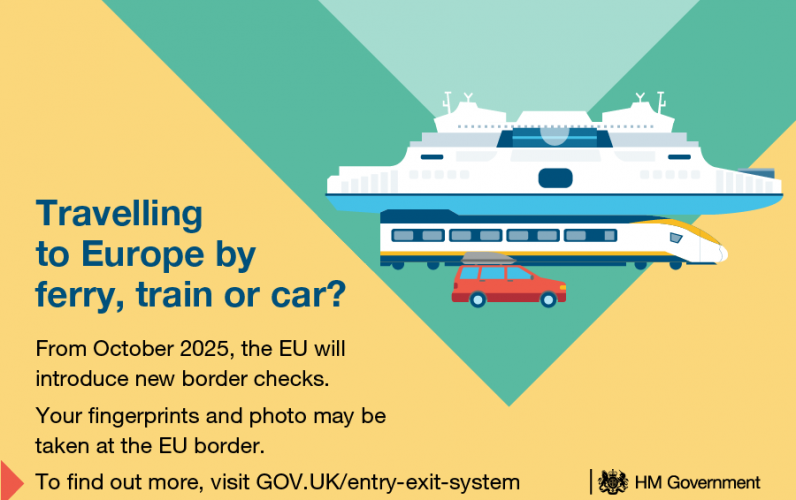The New Entry/Exit System (EES): what UK travellers need to know
What is EES?
From 12 October 2025 the EU will introduce new border checks known as the Entry/Exit System (EES), as part of its plans to modernise the border system. This will require British and non-EU citizens to provide biometric data at all Schengen area entry and exit points.
Why?
EES is designed to improve border security within the EU and its neighbouring countries, and reduce illegal migration in the Schengen area. It will automate border control checks to help Schengen member countries to prevent non-EU visitors from overstaying.
What will British citizens need to do?
From 12 October, non-EU travellers including most British citizens entering the Schengen area will be required to register their biometric details, such as fingerprints and a photo, and could be asked questions about their visit to the EU on arrival, as well as a further biometric check on their departure. As EES is being implemented through a phased rollout, this experience may vary during the first six months. Travellers do not need to take any action prior to arriving at the border, and there is no cost for EES registration.
What happens after implementation?
In late 2026, following the full implementation of EES, we expect the EU to introduce the ETIAS scheme. This will be a travel authorisation scheme like the UK's ETA. Further information can be found on the official Government website - EU Entry/Exit System - GOV.UK or ABTA website - Upcoming changes for travel to Europe | ABTA


What happens at the border?
1: Document scan
Your passport is scanned and your details checked against the system.
2: Facial image
A live photo is taken to match you to your passport.
3: Fingerprints (first time only)
On your first entry after launch, four fingerprints may be taken (not for children under 12). Later trips reuse your record.
4: Gate opens
Once checks are complete, you continue as normal. No more passport stamps.
How long does registration last?
Your EES record remains valid for three years from the date it’s created or until your passport expires—whichever comes first. After that, you’ll re‑register on your next trip.
Children & families
Under‑12s: no fingerprints; a photo is still captured.
All ages create a digital entry/exit record—keep families together in the queue to speed things up.
Who it applies to
Included
UK passport holders and other non‑EU/Schengen nationals travelling short‑stay (up to 90 days in any 180) to countries using EES.
Generally excluded
EU/Schengen citizens; non‑EU nationals holding EU/Schengen residence permits or long‑stay visas (they are checked using other systems).
Where it applies
At the external borders of countries using EES (most Schengen‑area states and some associated countries). It does not apply for travel entirely within the UK or Ireland.


What to expect by travel mode
Airports
Many airports will use staffed desks and self‑service kiosks for the first‑time registration step. Allow extra time, especially on peak days.
Ferries & Eurotunnel (car)
At Dover and Folkestone, French border checks happen before you depart the UK. Follow port signage and staff instructions for EES registration.
Eurostar (St Pancras)
Border checks are completed in London before boarding. Arrive earlier than usual while EES beds in.
Before you travel: quick checklist
✔️ Check your passport is valid (and has at least 6 months left if your destination requires it).
✔️ Build in extra time at departure for first‑time EES registration.
✔️ Keep family/group together through border checks.
✔️ Have glasses off/face uncovered for the photo where requested.
✔️ Keep your passport safe—your EES record links to it and lasts up to 3 years.


ETIAS is separate
ETIAS is a pre‑travel authorisation expected in late 2026. No action is required from travellers at this point. The European Union will inform about the specific date for the start of ETIAS several months prior to its launch.
FAQs
Will queues be longer?
At first, yes—first‑time registration adds steps. As more travellers complete registration, processing should speed up.
Do I need to do anything before I go?
No advance application for EES. Just allow extra time at the border for the first trip after launch. ETIAS, when it starts, will be done online in advance.
What data is taken?
Your name, travel document details, date and place of entry/exit, a facial image, and (except under‑12s) fingerprints on first entry.
How long is my record kept?
Your active EES record helps automate future crossings for up to three years (or until your passport expires), after which you’ll re‑register.
This page is informational only. Always follow instructions from border officials at your departure point.
Have questions? Visit the official Government page at EU Entry/Exit System - GOV.UK or ABTA - Upcoming changes for travel to Europe | ABTA
